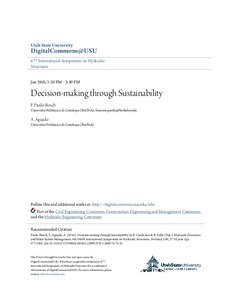Mostra el registre d'ítem simple
Decision-making through sustainability
| dc.contributor.author | Pardo Bosch, Francesc |
| dc.contributor.author | Aguado de Cea, Antonio |
| dc.contributor.other | Universitat Politècnica de Catalunya. Departament d'Enginyeria Civil i Ambiental |
| dc.date.accessioned | 2016-11-15T19:02:47Z |
| dc.date.available | 2016-11-15T19:02:47Z |
| dc.date.issued | 2016 |
| dc.identifier.citation | Pardo, F., Aguado, A. Decision-making through sustainability. A: International Symposium on Hydraulic Structures: Hydraulic Structures and Water System Management. "6th International Symposium on Hydraulic Structures: Hydraulic Structures and Water System Management, ISHS 2016". Portland, OR: 2016, p. 560-569. |
| dc.identifier.isbn | 9781884575754 |
| dc.identifier.uri | http://hdl.handle.net/2117/96699 |
| dc.description.abstract | From immemorial time, dams have contributed significantly for the progress of civilizations. For this reason, nowadays, there is a vast engineering heritage. Over the years, these infrastructures can present some ordinary maintenance issues associated with their normal operation or with ageing processes. Normally, these problems do not represent an important risk for the structure, but they have to be attended. To do it, owners of dams have to finance many ordinary interventions. As it is impossible to carry out all of them at the same time, managers have to make a decision and select the most “important” ones. However, it is not easy because interventions usually have very different natures (for example: repair a bottom outlet, change gates, seal a crack...) and they cannot use a classical risk analysis for these type of interventions. The authors, who are aware this problem, present, in this paper, a multi-criteria decision-making system to prioritize these interventions with the aim of providing engineers a useful tool, with which they can prioritize the interventions from the most important to the least. To do it, the authors have used MIVES. This tool defines the Prioritization Index for the Management of Hydraulic Structures (PIMHS), which assesses, in two phases, the contribution to sustainability of each intervention. The first phase measures the damage of the dam, and the second measures the social, environmental and economic impacts. At the end of the paper, a case of study is presented where some interventions are evaluated with PIMHS. |
| dc.format.extent | 10 p. |
| dc.language.iso | eng |
| dc.subject | Àrees temàtiques de la UPC::Enginyeria civil::Enginyeria hidràulica, marítima i sanitària |
| dc.subject.lcsh | Hydraulic engineering--Management |
| dc.subject.other | Dams |
| dc.subject.other | Decision making |
| dc.subject.other | Hydraulic structures |
| dc.subject.other | Risk analysis |
| dc.subject.other | Risk assessment |
| dc.subject.other | Waterworks |
| dc.subject.other | Ageing process |
| dc.subject.other | Engineering Heritage |
| dc.subject.other | Environmental and economic impacts |
| dc.subject.other | MCDM |
| dc.subject.other | MIVES |
| dc.subject.other | Multi criteria decision making |
| dc.subject.other | Normal operations |
| dc.subject.other | Prioritization |
| dc.title | Decision-making through sustainability |
| dc.type | Conference report |
| dc.subject.lemac | Enginyeria hidràulica |
| dc.contributor.group | Universitat Politècnica de Catalunya. EC - Enginyeria de la Construcció |
| dc.identifier.doi | 10.15142/T3700628160853 |
| dc.relation.publisherversion | http://digitalcommons.usu.edu/ishs/2016/Session9/2/ |
| dc.rights.access | Open Access |
| local.identifier.drac | 19160854 |
| dc.description.version | Postprint (published version) |
| local.citation.author | Pardo, F.; Aguado, A. |
| local.citation.contributor | International Symposium on Hydraulic Structures: Hydraulic Structures and Water System Management |
| local.citation.pubplace | Portland, OR |
| local.citation.publicationName | 6th International Symposium on Hydraulic Structures: Hydraulic Structures and Water System Management, ISHS 2016 |
| local.citation.startingPage | 560 |
| local.citation.endingPage | 569 |


